Unit 5 Do you have a soccer ball? Section A (1a~1c) 课件(共19张PPT,内嵌音频) 2023-2024学年人教版英语七年级上册
文档属性
| 名称 | Unit 5 Do you have a soccer ball? Section A (1a~1c) 课件(共19张PPT,内嵌音频) 2023-2024学年人教版英语七年级上册 | 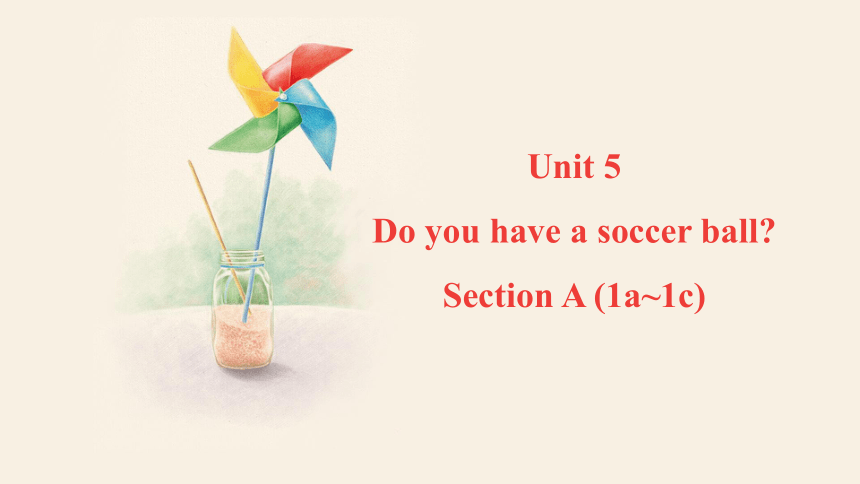 | |
| 格式 | pptx | ||
| 文件大小 | 2.2MB | ||
| 资源类型 | 教案 | ||
| 版本资源 | 人教新目标(Go for it)版 | ||
| 科目 | 英语 | ||
| 更新时间 | 2023-12-12 10:16:59 | ||
图片预览

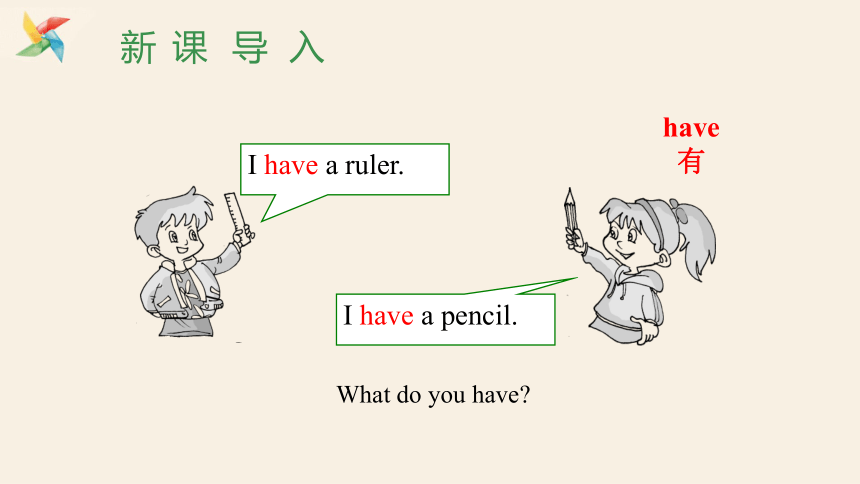

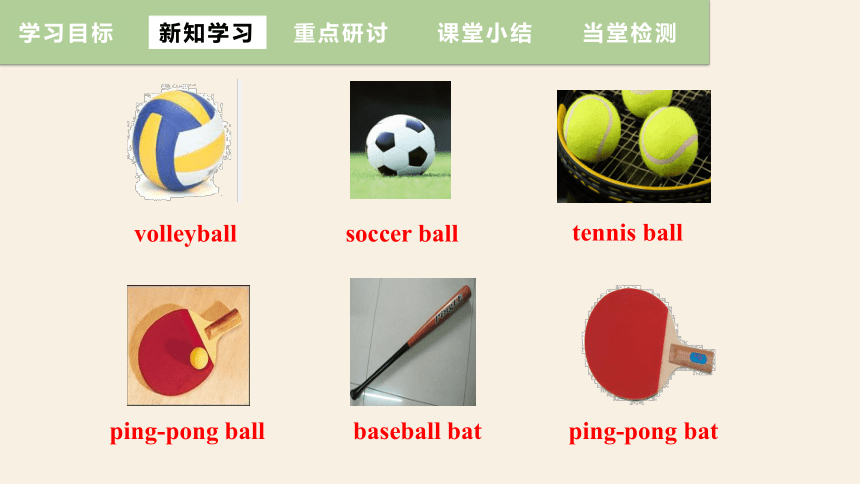
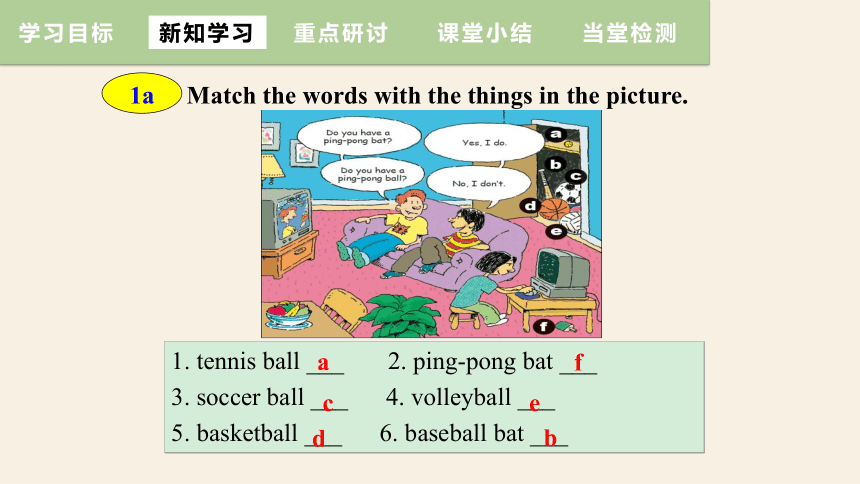
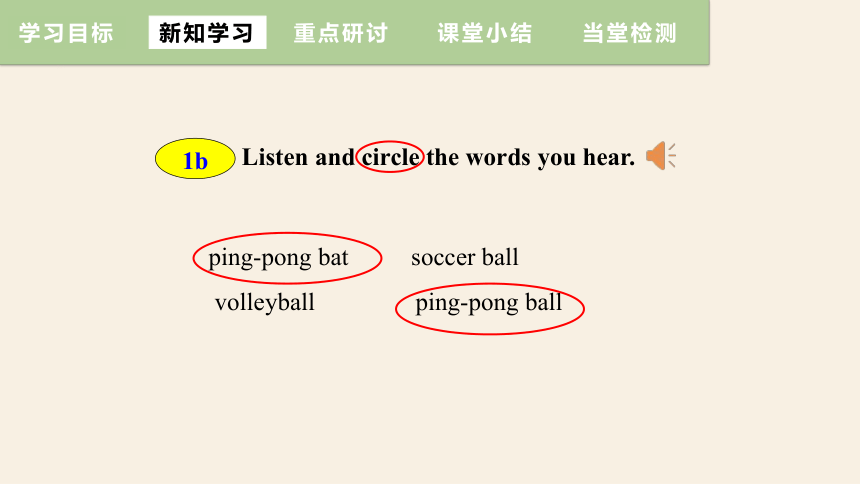
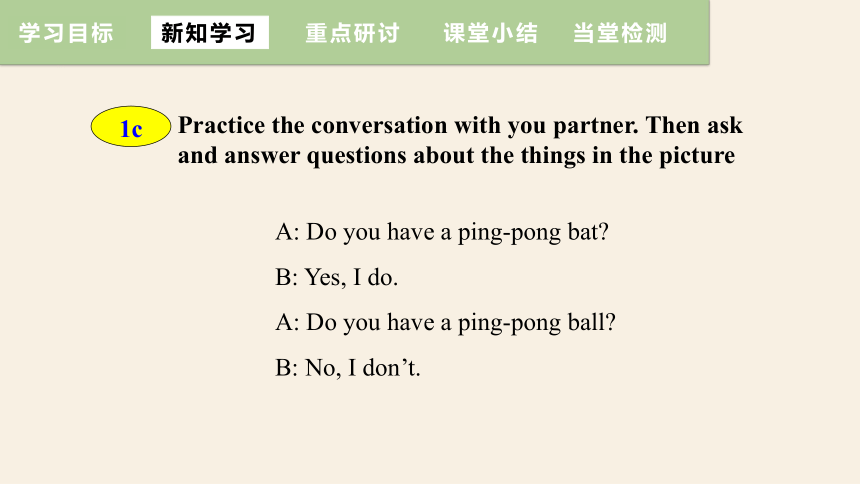
文档简介
(共19张PPT)
Unit 5
Do you have a soccer ball
Section A (1a~1c)
新
课
导
入
I have a ruler.
I have a pencil.
have有
What do you have
Language Goal
新知学习
课堂小结
当堂检测
学习目标
重点研讨
1.能熟记并能正确运用本课时的重点单词和短语
2.能运用句型Do you have... 对物品的所属关系
进行提问,并能用Yes, I do./ No, I don't.进行
肯定回答或否定回答
新知学习
课堂小结
当堂检测
学习目标
重点研讨
volleyball
soccer ball
tennis ball
ping-pong ball
baseball bat
ping-pong bat
新知学习
课堂小结
当堂检测
学习目标
重点研讨
1. tennis ball ___ 2. ping-pong bat ___
3. soccer ball ___ 4. volleyball ___
5. basketball ___ 6. baseball bat ___
a
f
c
e
d
b
1a
Match the words with the things in the picture.
新知学习
课堂小结
当堂检测
学习目标
重点研讨
ping-pong bat soccer ball
volleyball ping-pong ball
1b
Listen and circle the words you hear.
新知学习
课堂小结
当堂检测
学习目标
重点研讨
A: Do you have a ping-pong bat
B: Yes, I do.
A: Do you have a ping-pong ball
B: No, I don’t.
1c
Practice the conversation with you partner. Then ask and answer questions about the things in the picture
新知学习
课堂小结
当堂检测
学习目标
重点研讨
Do you have a / an…
Yes, I do. / No, I don’t. I have a …
Let's practice
新知学习
课堂小结
当堂检测
学习目标
重点研讨
A: Do you have a soccer ball
B: Yes, I do.
A: Where is the soccer ball
B: It’s on the floor.
Make a conversation
新知学习
课堂小结
当堂检测
学习目标
重点研讨
We want to have a ball game.
What kind of balls do you have
Names Do you have … Balls you have
Structures:
Do you have a … Yes, I do. / No, I don’t.
Do a Survey
新知学习
课堂小结
当堂检测
学习目标
重点研讨
Language points
英语中的人称和数(在一般现在时态中)在英语句子中,谓语动词的形式要与句子主语的人称和数相对应。
1.第一人称单数:I (我)
be → am, have → 原形have
I’m a girl. 我是一名女孩。
I have a volleyball. 我有一个足球。
新知学习
课堂小结
当堂检测
学习目标
重点研讨
2. 第一人称复数:we (我们)
be → are; have → 原形have
We’re good friends. 我们是好朋友。
We have two baseball bats. 我有两个棒球拍。
3. 第二人称单(复)数:you (你/你们)
be → are; have → 原形have
You are my cousin. 你是我的表弟。
You have three ping-pong bats.
你(们)有三只乒乓球拍。
新知学习
课堂小结
当堂检测
学习目标
重点研讨
句型“Do you have… ” “表示你有……吗?”,
用于询问物品的所属关系。
这是实义动词的一般疑问句结构。
1. 当主语是第一人称/第二人称/第三人称复数时,
句型结构为:Do + you/they/we/… + 动词原形 + …? 不管用什么动词,它的回答是固定的。
肯定回答:Yes, I do./ Yes, we do. / Yes, they do.
否定回答:No, I don’t /we don’t. /No, they don’t.
新知学习
课堂小结
当堂检测
学习目标
重点研讨
— Do they have basketball
他们有篮球吗?
— Yes, they do.
是的,他们有。
— No, they don’t.
不,他们没有。
新知学习
课堂小结
当堂检测
学习目标
重点研讨
do v. 用于构成否定句和疑问句; 做; 干
e.g
*Do you have a ping-pong bat
你有一个乒乓球拍吗
*Does Jane have a tennis ball
简有一个网球吗
*I don’t have a volleyball.
我没有排球。
*He doesn’t have a basketball.
他没有篮球。
*I often do homework at home in the evening.
我经常晚上在家里做作业。
新知学习
课堂小结
当堂检测
学习目标
重点研讨
do 的用法
(1) 作为助动词, do没有具体的含义, 帮助构成一般
疑问句或否定句。当主语是第三人称单数时助动词
do要变成does。
其基本句式为“Do/Does +主语+动词原形+. . . ”或
“主语+don’t/doesn’t+动词原形+. . . ”。
(2) 作为实义动词, do意为“做; 干”。
新知学习
课堂小结
当堂检测
学习目标
重点研讨
Unit 5
Section A
(1a~1c)
重点单词和短语:
have, baseball, volleyball, basketball, ping-pong bat , soccer ball, tennis ball
have的一般疑问形式及其肯否定回答:
一般疑问句Do/Does+主语+动词原形+其它;
肯定回答
Yes, sb. do/does.
否定回答
No, sb. don’t/doesn’t.
新知学习
课堂小结
当堂检测
学习目标
重点研讨
一、看图,写出下列球类名词的英文形式。
1. 2.
3. 4.
5. 6.
basketball
soccer ball
volleyball
tennis ball
ping pong ball
baseball
新知学习
课堂小结
当堂检测
学习目标
重点研讨
二、用所给单词的适当形式填空。
1. —Where is the basketball
—Let’s (ask) our teacher.
2. My brother (have) a soccer ball.
3. — you (have) a tennis bat
—Yes, I do.
4. your sister (have) a computer game
5. —Where (be) your ping-pong bat
—In my schoolbag.
ask
has
Do
have
Does
have
is
Unit 5
Do you have a soccer ball
Section A (1a~1c)
新
课
导
入
I have a ruler.
I have a pencil.
have有
What do you have
Language Goal
新知学习
课堂小结
当堂检测
学习目标
重点研讨
1.能熟记并能正确运用本课时的重点单词和短语
2.能运用句型Do you have... 对物品的所属关系
进行提问,并能用Yes, I do./ No, I don't.进行
肯定回答或否定回答
新知学习
课堂小结
当堂检测
学习目标
重点研讨
volleyball
soccer ball
tennis ball
ping-pong ball
baseball bat
ping-pong bat
新知学习
课堂小结
当堂检测
学习目标
重点研讨
1. tennis ball ___ 2. ping-pong bat ___
3. soccer ball ___ 4. volleyball ___
5. basketball ___ 6. baseball bat ___
a
f
c
e
d
b
1a
Match the words with the things in the picture.
新知学习
课堂小结
当堂检测
学习目标
重点研讨
ping-pong bat soccer ball
volleyball ping-pong ball
1b
Listen and circle the words you hear.
新知学习
课堂小结
当堂检测
学习目标
重点研讨
A: Do you have a ping-pong bat
B: Yes, I do.
A: Do you have a ping-pong ball
B: No, I don’t.
1c
Practice the conversation with you partner. Then ask and answer questions about the things in the picture
新知学习
课堂小结
当堂检测
学习目标
重点研讨
Do you have a / an…
Yes, I do. / No, I don’t. I have a …
Let's practice
新知学习
课堂小结
当堂检测
学习目标
重点研讨
A: Do you have a soccer ball
B: Yes, I do.
A: Where is the soccer ball
B: It’s on the floor.
Make a conversation
新知学习
课堂小结
当堂检测
学习目标
重点研讨
We want to have a ball game.
What kind of balls do you have
Names Do you have … Balls you have
Structures:
Do you have a … Yes, I do. / No, I don’t.
Do a Survey
新知学习
课堂小结
当堂检测
学习目标
重点研讨
Language points
英语中的人称和数(在一般现在时态中)在英语句子中,谓语动词的形式要与句子主语的人称和数相对应。
1.第一人称单数:I (我)
be → am, have → 原形have
I’m a girl. 我是一名女孩。
I have a volleyball. 我有一个足球。
新知学习
课堂小结
当堂检测
学习目标
重点研讨
2. 第一人称复数:we (我们)
be → are; have → 原形have
We’re good friends. 我们是好朋友。
We have two baseball bats. 我有两个棒球拍。
3. 第二人称单(复)数:you (你/你们)
be → are; have → 原形have
You are my cousin. 你是我的表弟。
You have three ping-pong bats.
你(们)有三只乒乓球拍。
新知学习
课堂小结
当堂检测
学习目标
重点研讨
句型“Do you have… ” “表示你有……吗?”,
用于询问物品的所属关系。
这是实义动词的一般疑问句结构。
1. 当主语是第一人称/第二人称/第三人称复数时,
句型结构为:Do + you/they/we/… + 动词原形 + …? 不管用什么动词,它的回答是固定的。
肯定回答:Yes, I do./ Yes, we do. / Yes, they do.
否定回答:No, I don’t /we don’t. /No, they don’t.
新知学习
课堂小结
当堂检测
学习目标
重点研讨
— Do they have basketball
他们有篮球吗?
— Yes, they do.
是的,他们有。
— No, they don’t.
不,他们没有。
新知学习
课堂小结
当堂检测
学习目标
重点研讨
do v. 用于构成否定句和疑问句; 做; 干
e.g
*Do you have a ping-pong bat
你有一个乒乓球拍吗
*Does Jane have a tennis ball
简有一个网球吗
*I don’t have a volleyball.
我没有排球。
*He doesn’t have a basketball.
他没有篮球。
*I often do homework at home in the evening.
我经常晚上在家里做作业。
新知学习
课堂小结
当堂检测
学习目标
重点研讨
do 的用法
(1) 作为助动词, do没有具体的含义, 帮助构成一般
疑问句或否定句。当主语是第三人称单数时助动词
do要变成does。
其基本句式为“Do/Does +主语+动词原形+. . . ”或
“主语+don’t/doesn’t+动词原形+. . . ”。
(2) 作为实义动词, do意为“做; 干”。
新知学习
课堂小结
当堂检测
学习目标
重点研讨
Unit 5
Section A
(1a~1c)
重点单词和短语:
have, baseball, volleyball, basketball, ping-pong bat , soccer ball, tennis ball
have的一般疑问形式及其肯否定回答:
一般疑问句Do/Does+主语+动词原形+其它;
肯定回答
Yes, sb. do/does.
否定回答
No, sb. don’t/doesn’t.
新知学习
课堂小结
当堂检测
学习目标
重点研讨
一、看图,写出下列球类名词的英文形式。
1. 2.
3. 4.
5. 6.
basketball
soccer ball
volleyball
tennis ball
ping pong ball
baseball
新知学习
课堂小结
当堂检测
学习目标
重点研讨
二、用所给单词的适当形式填空。
1. —Where is the basketball
—Let’s (ask) our teacher.
2. My brother (have) a soccer ball.
3. — you (have) a tennis bat
—Yes, I do.
4. your sister (have) a computer game
5. —Where (be) your ping-pong bat
—In my schoolbag.
ask
has
Do
have
Does
have
is
同课章节目录
- starters 预备篇(2012秋审查)
- Unit 1 Good morning !
- Unit 2 What’s this in English?
- Unit 3 What color is it ?
- Unit 1 My name's Gina.
- Section A
- Section B
- Unit 2 This is my sister.
- Section A
- Section B
- Unit 3 Is this your pencil?
- Section A
- Section B
- Unit 4 Where's my schoolbag?
- Section A
- Section B
- Unit 5 Do you have a soccer ball?
- Section A
- Section B
- Unit 6 Do you like bananas?
- Section A
- Section B
- Unit 7 How much are these socks?
- Section A
- Section B
- Unit 8 When is your birthday?
- Section A
- Section B
- Unit 9 My favorite subject is science.
- Section A
- Section B
